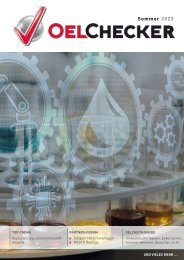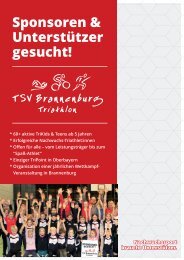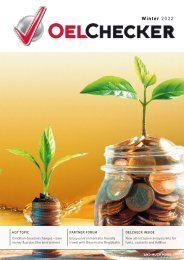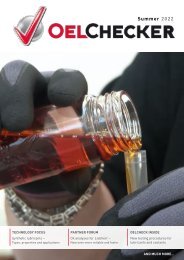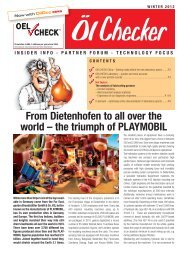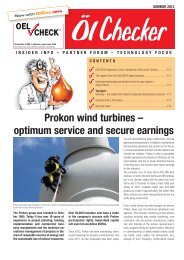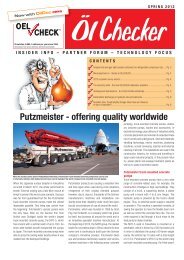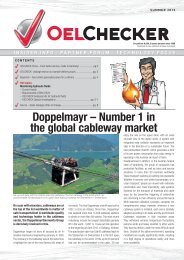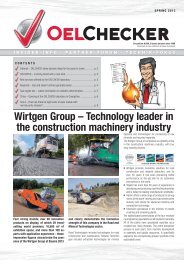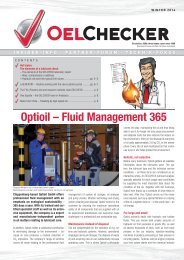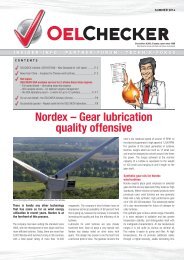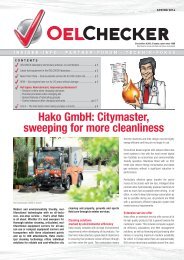OELCHECKER - Winter 2013
> Bauer Maschinen revolutionises special foundation engineering > OELCHECK identifies solid impurities in lubricating greases > CM Technologies – condition monitoring on the high seas > Hot Topics: > The study of filter residues > The critical aspects of oil purity and filtering > What filter residues reveal – an example from real life > Extract filter samples correctly > Filter residue analyses in the OELCHECK laboratory > LEIPA - world-leading with quality products based on scrap paper > Requested – soot index for oils from petrol engines
> Bauer Maschinen revolutionises special foundation engineering
> OELCHECK identifies solid impurities in lubricating greases
> CM Technologies – condition monitoring on the high seas
> Hot Topics:
> The study of filter residues
> The critical aspects of oil purity and filtering
> What filter residues reveal – an example from real life
> Extract filter samples correctly
> Filter residue analyses in the OELCHECK laboratory
> LEIPA - world-leading with quality products based on scrap paper
> Requested – soot index for oils from petrol engines
Create successful ePaper yourself
Turn your PDF publications into a flip-book with our unique Google optimized e-Paper software.
Check-up<br />
To improve is to change; to be perfect is to change often. This<br />
quote comes from Winston Churchill, the former British prime<br />
minister. It is more than 60 years old but it still remains just as<br />
valid. Even if we probably never really achieve it, perfection remains<br />
our major aim. At OELCHECK, we are always changing in order to<br />
get even better. This is all for our customers because we want to<br />
offer the best service to them. To this end, we are currently working<br />
on two large projects.<br />
On 1 January 2014, we are switching to SAP Business One.<br />
Our previous merchandise management has served us loyally<br />
since 2001 but it has now reached its limitations. In particular,<br />
new tax guidelines cannot be implemented at all or only with a great deal of inconvenience. Our<br />
employees have been intensively trained so that the switchover to SAP Business One will pass off<br />
smoothly and our customers and suppliers will only notice the new design of our offers and orders,<br />
invoices and credit notes.<br />
Our software developers are also working under extreme pressure alongside an external company<br />
on an essential relaunch of our web portal. Some well-known functions are being optimised<br />
in the process and lots of new ones are being added. Amongst other things, the recording of<br />
data on new specimens of already recorded machines will also be possible on mobile devices „on<br />
site“. In the course of the first quarter of 2014 this means: curtain up for the new OELCHECK web<br />
portal – with a new look and many additional useful functions which will simplify the work of not only<br />
the customers but also the OELCHECK employees.<br />
Yours, Barbara Weismann<br />
achieve a connection that is as close as possible<br />
between the two trenches, the joint is provided with<br />
suitable sealing elements using trench wall grabbers.<br />
40 to 80 metres in depth can be achieved<br />
with the method based on excavator buckets. This<br />
conventional excavation is difficult on hard ground<br />
and impossible on rock. Trench walls can be manufactured<br />
in the most difficult ground conditions only<br />
by using Bauer trench cutters. Two typical examples<br />
of this are the trench wall for the Dhauligangha<br />
embankment dam project in the Indian Himalayas<br />
and the trench walls for the embankment dam of<br />
the Peribonka hydropower station in Canada where<br />
hard rock of up to 120 m depth had to be cut into.<br />
The cutting machines work at -20 °C as well as<br />
at +40 °C. They are successfully used in remote<br />
regions in the Arctic circle but also in the vibrant<br />
centres of large cities such as Hong Kong, Tokyo,<br />
Turin or Moscow.<br />
The Bauer cutting system is made from many independent<br />
components which are coordinated with<br />
each other according to use, depth and ground<br />
type. The main components are: trench cutter, cutting<br />
control, twisting mechanism, hose guidance<br />
system and carrier.<br />
The core item of the system, the actual trench cutter,<br />
is made from a steel frame on the underside of<br />
which two hydraulically operated gear cylinders are<br />
arranged which rotate around the horizontal axis<br />
in opposite directions. Different cutting wheels are<br />
assembled on the gears depending on the ground<br />
type. Through the rotation of these cutting wheels<br />
the ground material is continuously loosened under<br />
the cutter, crushed, mixed with the suspension in<br />
the trench and fed to a vacuum outlet. In order to<br />
be able to wear the strokes occurring during the<br />
smashing of large rocks undamaged, there are<br />
damping elements installed between the cutting<br />
wheels and gears for the protection of the transmission.<br />
Close above the cutting wheels, there is a<br />
hydraulically operated rotary pump. It continuously<br />
carries the suspension concentrated with the cut<br />
material upwards and from there on to the processing<br />
plant. In soft ground and when using hard<br />
suspensions, the capacity of this pump is crucial<br />
for the excavation output. Cutting transmission and<br />
feed pump are protected against harmful concrete<br />
entry using a pressure equalisation system. The<br />
output of a cutting machine is dependent on the<br />
feeding force, designated by the weight of the cutting<br />
machine and the torque of the cutting wheels.<br />
Both factors mutually influence each other. In order<br />
to achieve an optimal excavation output, the Bauer<br />
cutting systems are equipped with a particularly<br />
sensitive, electronically controlled feed winch for<br />
the control of the contact pressure.<br />
Although the Bauer trench cutters are extremely<br />
robustly designed, the hydraulics system and gear<br />
cylinders must be carefully maintained. Finally, they<br />
should work reliably both at areas at the equator<br />
and also in the extreme north of Canada. In the process,<br />
the conditions of use could often not be more<br />
challenging and the surroundings more adverse to<br />
machines. The cutting machines work for example<br />
immersed in the supporting liquid (bentonite) up to<br />
depths of 150m with a high bandwidth of the operating<br />
temperatures and changing pressure conditions.<br />
The gears, drive motors and control systems<br />
are exposed to extreme contamination and water<br />
levels, high temperatures and strong vibrations.<br />
The maintenance of the devices is mostly assumed<br />
by the users using a detailed maintenance plan<br />
provided by Bauer. Upon request, for example for<br />
rented devices, the service will also be assumed by<br />
Bauer. However, regardless as to who carries out<br />
the maintenance work, Bauer always recommends<br />
that an accompanying monitoring of the components<br />
filled with oil using OELCHECK lubricant analyses<br />
in its machine documentation. In the event of<br />
an extended warranty, they are even mandatory.<br />
The hydraulics systems are operated with 700 to<br />
1,400 litres of mineral oil-based or „bio“ hydraulic<br />
fluid, depending on the cutting. The oil corresponds<br />
to the guidelines of the carrier, whose system it also<br />
comes from. The gear cylinders require 30 to 130<br />
litres of synthetic gear oil each.<br />
For the hydraulic liquids, the<br />
lubricant analyses together with<br />
the impurity check mainly serve<br />
as an excellent instrument to<br />
control the oil change intervals<br />
in a condition-based manner.<br />
The oil change intervals are<br />
fixed for the highly loaded gears.<br />
Here, Bauer uses the analyses<br />
principally to assess the wear<br />
and tear of gears and their components<br />
and the functionality of<br />
the gaskets.<br />
In addition, the analyses also always<br />
provide important information<br />
if irregularities occur. In this<br />
way, they also detect the cause<br />
for a sudden dark colouration<br />
of a hydraulic oil from a trench<br />
cutter. In the laboratory, an impurity<br />
of the hydraulic oil was<br />
discovered through engine oil.<br />
Thanks to this information, the<br />
Bauer service technicians were<br />
able to specifically search for<br />
the defect without long delays.<br />
The engine oil had entered the<br />
hydraulics system through a<br />
power take-off in the diesel<br />
engine. Once detected, the<br />
cause was quickly fixed and<br />
the hydraulics protected from<br />
possible resultant damage.<br />
2<br />
Further information: www.bauer.de
OELCHECK INSIDER INFO<br />
NEW<br />
OELCHECK identifies solid impurities<br />
in lubricating greases<br />
OELCHECK laboratory manager, Jan Hubrig, at the OLYMPUS<br />
special microscope<br />
With almost 10,000 tests of used<br />
lubricating grease specimens this year,<br />
OELCHECK is the world-leading service<br />
laboratory for waste grease analyses.<br />
Affordable analysis sets are available<br />
for the routine inspection of lubricating<br />
greases. Almost all everyday problems<br />
can be covered off with the testing<br />
methods included in the kit.<br />
In addition, further special tests are available, for<br />
example for experimental observations or questions<br />
in connection with stock disturbances. One of<br />
these is the determination of the amount and type<br />
of particles and solid impurities which are found in<br />
the lubricating greases used. Mostly, such particles<br />
which originate from slowly running rolling bearings<br />
or swing bearings are visible in the grease specimens<br />
to the naked eye (>70 µm). Alongside soft<br />
particles from the grease ageing and solid impurities<br />
(dust) from the surroundings, such greases<br />
often contain metallic wear debris from the components<br />
of the bearing such as bearing cages, tracks<br />
or rolling elements. The shape, hardness, amount<br />
and size of the solid impurities influence the service<br />
life of the rolling bearings. Therefore, increasingly<br />
higher demands for improved cleanliness are<br />
placed not only on the oils but also the lubricating<br />
greases.<br />
For the determination of stubborn component parts<br />
there is a method defined in DIN 51813 – however<br />
only for fresh greases – of how solid materials<br />
of over 25 µm in piece size can be quantitatively<br />
detected through high pressure filtration using<br />
a filter with a 0.025 mm pore size from a large<br />
fresh grease amount of 0.5 kg. This method is not<br />
suitable for waste grease analyses. Processing the<br />
specimens in accordance with this standard is only<br />
used in the OELCHECK laboratory for the tests not<br />
requiring much effort.<br />
For the waste grease analysis,<br />
the identification of wear or<br />
impurity elements and additives<br />
belongs to the standard<br />
of an analysis set. For this 27<br />
elements such as iron, chromium,<br />
silicon, sodium, zinc<br />
and phosphorus are identified<br />
in accordance with the Rotrode<br />
method. The element<br />
contents are given in mg/kg.<br />
Unfortunately, very large particles<br />
can only be viewed with<br />
the atom emission spectroscopy<br />
up to a size of approximately<br />
5 µm through the LDE arc, with which the individual<br />
component parts are stimulated.<br />
If there are visible particles (>70 µm) in a waste<br />
grease specimen, the identification of the elements<br />
is not always precise. Here, conclusions can be<br />
drawn on the wear condition of the lubricated elements<br />
with the „Identification of the content of<br />
stubborn materials“. However, this method only<br />
functions for soap thickened lubricating greases<br />
without solid lubricants. Three grams of lubricating<br />
grease are required.<br />
In order to be able to filter out the impurities from<br />
the grease, the solid grease must be dissolved. This<br />
occurs with intensive stirring after adding a solvent<br />
mixture of methylene chloride, ethanol, heptane<br />
and acetic acid under temperature influence. By<br />
destroying the soap structure, the grease becomes<br />
liquid and can be filtered. The solid particles are<br />
separated during filtration with a special 10 µm Teflon<br />
membrane. After washing out and drying, the<br />
membrane can be used to calculate the percentage<br />
of solid materials using a differential weighing. In<br />
the laboratory report, the content of solid impurities<br />
appears with a particle size of over 10 µm as a<br />
mass in mg/kg. An image of the membrane from<br />
which the shape of the particles follows is supplied.<br />
OELCHECK does not only identify the content of<br />
solid impurities in the grease specimen but also<br />
carries out some further tests. Only using this<br />
method can even more precise conclusions be<br />
drawn on any wear processes.<br />
The particles caught in the Teflon filter are recorded<br />
with the help of an OLYMPUS special microscope.<br />
The large particles are recorded individually and microscopically<br />
scanned in incidental light mode. All<br />
particles appearing darker in the grey scale of the<br />
membrane are photographed with a high-resolution<br />
CCD camera. Through differing reflection using<br />
polarised light, a distinction can be made between<br />
metallic and non-metallic impurities. This information<br />
as well as the shape and colour of the particles<br />
provides the diagnostic engineer with important information<br />
on the type of the materials present (cage,<br />
rolling elements, inner or outer ring) and a possible<br />
wear process (outbreaks due to fatigue, wear due<br />
to hard impurities and corrosion).<br />
Metal particle under the scanning<br />
electron microscope<br />
If particles remain on the Teflon membrane and<br />
the amount of remaining grease used is still sufficient,<br />
a further analysis with the REM-EDX method<br />
presents itself. REM stands for „scanning electron<br />
microscopy“ and EDX for „energy dispersive X-ray<br />
spectroscopy“. In order to record the particles with<br />
this, the dissolved grease must however be filtered<br />
with a gold filter membrane. The membrane is<br />
then observed and evaluated under a vacuum with<br />
the scanning electron microscope. In the process,<br />
an electron beam goes in a certain pattern over<br />
the enlarged depicted object. The interactions of<br />
the electrons with the wear particles on the filter<br />
are used to create an image. The electron beam<br />
has a relatively small diameter, hits the particles<br />
separately and provides images with a very high<br />
resolution.<br />
The energy dispersive X-ray analysis spectroscopy<br />
connected to the REM serves to determine the elemental<br />
composition of the material. If an electron<br />
from the electron beam in an atom of the specimen<br />
hits a electron close to the nucleus from its position,<br />
this is immediately filled in by a high-energy electron<br />
from a higher electron orbit. The energy difference<br />
is established in the form of an X-ray quantum.<br />
The X-rays that result are each characteristic for a<br />
certain element. The composition of the particles is<br />
recognised using special detectors. Wear processes<br />
can be located even more precisely through the<br />
metal alloys determined in this way such as FeCr,<br />
CuPbSn.<br />
3
OELCHECK PARTNER FORUM<br />
CM Technologies – condition<br />
monitoring on the high seas<br />
Skilled labour is demanded on drilling platforms,<br />
freighters, cruise or container ships If<br />
a technical fault occurs on a „factory at sea“,<br />
the crew must get to grips with it themselves.<br />
External service engineers are only available<br />
again in the next shipping port. Maximum<br />
operational safety and a comprehensive<br />
condition monitoring system are therefore<br />
particularly important at sea.<br />
The condition of the drive units and also pumps,<br />
cranes, winches and many other systems need to<br />
be constantly monitored. In addition, the quality of<br />
the drinking water, the safety of waste water and<br />
even the cooling and boiler water must be checked.<br />
For this range of tasks CM Technologies GmbH/<br />
Elmshorn, known previously as Kittiwake GmbH,<br />
offers tailored solutions with online and offline<br />
monitoring systems. Depending on the system<br />
type and operating conditions, the following technologies<br />
are combined:<br />
• lubrication and fuel monitoring on site using CMT<br />
rapid test devices.<br />
• regular analysis of specimens in the OELCHECK<br />
laboratory<br />
• vibration analysis for early damage detection<br />
• monitoring of physical parameters (speed, rotation<br />
speed, pressure, temperature and output)<br />
using sensors.<br />
The monitoring of large marine engines is one of<br />
the core competences of CMT. Passenger and<br />
medium-sized cargo ships are often driven by fourstroke<br />
diesel engines with an output of more than<br />
50,000 kW. By contrast, large cargo and container<br />
ships are powered with slowly running two-stroke<br />
diesel engines with a driving power of up to 10,000<br />
kW - the rotation speeds achieve between 35 and<br />
100 rpm. Up to 14 cylinders are installed in series.<br />
The force is transmitted directly on to the propeller.<br />
At full speed, speeds of up to 25 kn (45 km/h) are<br />
achieved. The weight of a engine of about 13 m<br />
high and 32 m long is almost 3,000 tonnes.<br />
Two different oil types are used in a slow-running<br />
two-stroke diesel engine.<br />
• An SAE 50 (sometimes also SAE 40) cylinder oil<br />
is injected directly into the individual cylinder or<br />
fed in using a central lubrication pump. It must<br />
not only lubricate but primarily it must protect the<br />
components from corrosive wear by neutralising<br />
combustion residues. Most of it is burned with<br />
the fuel. In the process large ships use 2 tonnes<br />
and more of cylinder oil per day. Remaining<br />
quantities are caught on the cylinder shroud as<br />
Removal of a representative oil specimen from the engine of a marine engine.<br />
„drip oil“ which then is analysed in the lab for the<br />
optimisation of the relubrication quantity.<br />
• An SAE 30 or SAE 40 system oil lubricates the<br />
connecting-rod bearings and all other moving<br />
parts of the engine using a complex circulation<br />
system. The system for engine transmission<br />
lubrication takes a lot more than 10,000 litres.<br />
Normally the oil is never changed completely but<br />
a partial change of a maximum of 30% always<br />
takes place depending on oil analyses.<br />
Only monograde engine oils are used. In the process<br />
the cylinder and system oils and the oils for<br />
four-stroke marine diesel have a considerably higher<br />
alkaline reserve (BN) than oils for car or truck<br />
engines due to the combustion of high sulphur fuels.<br />
The check of engines and power units on ships<br />
should take place as far as possible without human<br />
intervention. The monitoring of general machine<br />
condition, wear behaviour and oil situation with a<br />
single sensor is still a thing of the future. However,<br />
CMT has developed an optimal solution with its<br />
monitoring systems. The systems combine different<br />
monitoring modules in one unit. The installation<br />
near the lubricating oil system is simple. Effective<br />
distance maintenance is possible through data<br />
transfer. All online sensors from CMT can be combined<br />
in such a way that metallic abrasion and wear,<br />
the oil situation, oscillations and vibrations, temperatures<br />
and other parameters can be recorded. CMT<br />
offers an extensive service for installation, startup<br />
or repair of the condition monitoring systems.<br />
Service technicians from the company also go on<br />
board as a matter of course. In addition, there is a<br />
network of agents available at all central locations<br />
round the globe.<br />
CMT carries out special training and seminars so<br />
that everything runs perfectly at sea. Finally, a<br />
good understanding of condition monitoring by the<br />
ship crews has a direct influence on the lifetime<br />
and reliability of the systems. The training sessions<br />
also include the subject of „Oil - the elixir of life“. In<br />
particular, the oils for marine diesel engines have<br />
extreme challenges to overcome. Normally, HFO<br />
(heavy fuel oil) is used as fuel. Its quality not only<br />
varies constantly but it is also relatively heavily polluted<br />
with water, silicon, nickel vanadium and above<br />
all sulphur. However, the engine oil of the fourstrokes<br />
and the cylinder oil of the slowly running<br />
two-strokes not only have to cope with pollution<br />
from the heavy oil but also with changing feeding<br />
rates and humidity. In order to be able to neutralise<br />
the sulphur, which can still be up to 4.5% at the<br />
moment, oils with a high base number (BN) of up<br />
to 100 are used. If the base number decreases too<br />
much, there could be damage from the aggressive<br />
effect of the acids which result from the combustion<br />
of sulphur. The CMT online sensors should recognise<br />
changes in the oil early which possibly could<br />
be indicative of a wear process or of inadequate lubrication.<br />
In order to err on the side of caution, CMT<br />
also recommends additional regular lubricant analyses.<br />
In order to be able to offer the ship customer<br />
a tailored laboratory analysis service in this area,<br />
CMT and OELCHECK have gone into partnership.<br />
They are a necessary addition particularly for trend<br />
analyses. The laboratory in Brannenburg offers<br />
more possibilities to test an oil systematically than<br />
the sensors or the rapid test method on board. The<br />
ship engineers receive comprehensive information<br />
on wear values, impurities, the oil condition, the<br />
4
important titrated base number and the remaining<br />
oil additives with the analysis results which have<br />
comments.<br />
In addition, the OELCHECK engineers make important<br />
suggestions in their comments on problems<br />
with the system or the oil. Analysing the „drip oil“<br />
involves the influence of the heavy oil polluted with<br />
sulphur and other impurities on the cylinder oil of<br />
the large two-stroke diesel engines. Then there are,<br />
for example recommendations to check the sulphur<br />
content of the heavy oil and adjust the dosage of<br />
the cylinder lubricating oil accordingly. If the cylinders<br />
are supplied with too much oil, it can also<br />
quickly result in deposits on the piston crown as<br />
well as a greater impact on the environment and<br />
to the purse strings. Too little lubrication, however,<br />
leads to increased wear and also often to a piston<br />
seizure. Through a leak on the stuffing box of the<br />
piston rod, increased entry of cylinder oil into the<br />
circulating oil can occur. Through this, more than<br />
10,000 litres of oil are then limited in performance<br />
in such a way that a partial exchange has to take<br />
place. Nevertheless, it is only when the oil analyses<br />
show that too much cylinder oil has gone into the<br />
circulating oil that those responsible on board have<br />
the capacity to isolate the cause of it.<br />
OELCHECK has become an important partner of<br />
CM Technologies GmbH over the years. The analysis<br />
sets for the most diverse of usage scenarios<br />
and the tools for taking specimens are a permanent<br />
feature of CMT‘s range. Through this partnership,<br />
lubricant specimens from ports all around the world<br />
arrive almost daily at OELCHECK in Brannenburg.<br />
www.CMTechnologies.de<br />
OELCHECK TECHNOLOGY FOCUS<br />
What filter deposits reveal ...<br />
Modern gears, motors or hydraulics - they are all designed to become more compact and energy efficient yet deliver a higher performance.<br />
This trend often also comes with increasing operating pressure and more precision-manufactured components. Higher<br />
demands are made of the quality and purity of the lubricant. Consequently, many systems are also equipped with increasingly finer<br />
main and secondary current filters. Accordingly, the proof of external and dirt particles in oil as well as the determination of the<br />
purity class have an increasingly decisive role to play in lubricant analytics. Admittedly, caution is also advised when it concerns<br />
oil purity and filtering ....<br />
Representative section<br />
Largest particle<br />
Three crucial aspects are to be considered:<br />
• Trend analyses show „everything is in the green<br />
area“. Operators are often inclined to extend<br />
the check intervals if the required high degree<br />
of oil purity is confirmed. However, if changes<br />
suddenly occur in the oil, they will no longer be<br />
discovered in time.<br />
• The fine filters can be effective to the extent that,<br />
in some cases, the active substances of the oil<br />
can also be filtered out. Mainly additives such as<br />
silicone de-foamers, viscosity index improvers or<br />
detergents are affected by this. If they remain<br />
hanging around in the filter, they themselves can<br />
impair the productive capacity of the lubricant.<br />
• Worn particles from wear processes, or foreign<br />
particles registered from the outside, can and<br />
should be held by the filter. During sampling,<br />
such particles do not end up in the sample container.<br />
As a result, important data medias that<br />
otherwise tell us about problems during lubricant<br />
analyses are extracted from the oil.<br />
• Consequently, waste oil from a system with<br />
optimal filtration merely reflects an incomplete<br />
picture of the lubrication and system status. In<br />
these cases, the analysis of the filter deposits<br />
completes the actual discovery first.<br />
A case study in practice<br />
The person accountable had been aware of the<br />
critical state of the gearing of a highly loaded rolling<br />
mill drive in a cement mill for a long time. The<br />
ordered replacement gear wheels, however, were<br />
only be assembled during the major revision some<br />
months later in order to avoid an operational stoppage.<br />
The gear was closely monitored by lubricant<br />
analyses. The attrition values determined were<br />
measured over weeks in the tolerable range and<br />
alarming deviations were not recorded. However,<br />
a filter change was then signalled on the basis of<br />
a changed differential pressure. The maintenance<br />
workers noticed a suspiciously high loading of the<br />
filter with metal abrasion. During an inspection<br />
made at short notice, a tear was discovered - along<br />
with many outbreaks (pittings) - which indicated<br />
an imminent tooth-breakage. The gear had to be<br />
exchanged as quickly as possible.<br />
Had the lubricant analyses failed in this case? Why<br />
hadn‘t the laboratory flagged this up in time? Could<br />
something like this happen again?<br />
The maintenance workers wanted to know precise<br />
details. They sent in an oil specimen again. This<br />
time too the investigation results were within the<br />
tolerated range. Both the PQ index for the total<br />
amount of magnetisable iron in the sample and the<br />
portion of iron particles determined with the ICP<br />
spectometry, which are smaller than 3 µm were not<br />
alarmingly high.<br />
But quite different values were to be seen in the<br />
filter deposit investigation. For this purpose, the<br />
deposits of a 50mm x 50mm piece were extracted<br />
in the laboratory using solvent. Here, metallic wear<br />
particles with a diameter of up to 80 µm and large<br />
dirt particles with a diameter of up to 100 µm were<br />
manifested.<br />
The filter deposits, and not the gear oil, were<br />
the deciding data media in this case.<br />
However, it was not simply the proof of wear<br />
that was conveyed here. The large dirt particles<br />
had to have penetrated into the gear oil from the<br />
outside. During a further gear examination, it was<br />
ascertained they had got in through a defective<br />
ventilation filter. From this, the cause of wear was<br />
also found.<br />
5
OELCHECK TECHNOLOGY FOCUS<br />
Extract filter specimens correctly<br />
Oil checks can be made with the OELCHECK analysis<br />
sets and a sampling pump, or removed cleanly,<br />
quickly and simply via a built-in valve in front of the<br />
filter. With residue from the filter cartridge, this is<br />
a little more intricate because we do not need the<br />
complete filter; rather we need a 50mm x 50mm<br />
large representative piece of the filter mesh only.<br />
Please do not send us the entire filter in any<br />
case.<br />
As a laboratory, we do have the mechanical scope<br />
to remove filter mesh. This would also result in additional<br />
costs for you for its disposal. You can send<br />
the filter mesh of approximately 50mm x 50mm in<br />
a pre-paid sample container.<br />
We demonstrate how you can remove a representative<br />
piece of filter mesh as an example from a completely<br />
enclosed main current filter of a wind energy<br />
system (also see www.oelcheck.de/downloads).<br />
1. Remove the filter and let it drip out.<br />
2. Locate the metal filter housing (only if the filter<br />
is built into metal housing). First unlock the casing<br />
at the flared flange. Open the sheet housing<br />
using a corner slider or an iron saw. While doing<br />
so avoid a contamination of the filter material.<br />
Note: Wearing protective clothing is strongly<br />
advised.<br />
3. Usually the filter material is channelled from<br />
the outside inwards. The actual 2 or 3 layered<br />
filter material is protected by a metallic fabric.<br />
Remove this with the help of wire cutters or a<br />
cutting knife in an area that is representative<br />
and well streamed.<br />
4. Now cut a representative piece of the multi-layered<br />
filter mesh (approximately 50mm x 50mm).<br />
Avoid contact with the bit of filter that has<br />
connective fabric or housing.<br />
5. Send the material to our laboratory<br />
in a pre-paid sample<br />
container with „residue analysis“<br />
noted on the sample submission<br />
form. State the sample number<br />
as the reference which the appropriate<br />
oil sample will be analysed<br />
under.<br />
The filter analysis in the OELCHECK<br />
laboratory<br />
After an initial optical appraisal of the sample fabric,<br />
the diagnostics engineer will choose the analysis<br />
procedures. As filter residue cannot be used like<br />
oil samples with our test equipment, the devices<br />
are either re-equipped or modified procedures<br />
are used.<br />
PQ index - searching for iron<br />
The PQ index tells us about the content of magnetisable<br />
iron as a dimensionless numerical value.<br />
If this value is clearly higher than the index found<br />
in oil, insignificant wear does not appear with the<br />
iron-containing components of the aggregate from<br />
which the filter originates. The PQ index works independent<br />
of the particle size. The test principle<br />
uses the fact that iron abrasion interferes with<br />
the magnetic field. The quantity of all magnetised<br />
iron particles (in this case, rust particles are not<br />
magnetisable) in the filter residue is determined<br />
in a magnetic-inductive manner. The index, which<br />
is named after the Kittiwake „Particle Quantifier“<br />
testing equipment and called the PQ index for short,<br />
indicates the measurement result.<br />
The RDE determines additives and wear<br />
RDE stands for Rotating Disk Electrode. The filter<br />
residue becomes stimulated after wetting, where<br />
necessary, with pure „0-ppm control oil“ directly on<br />
a „function cog“. In the arc that forms during a high<br />
voltage of 10 kV between the residue-occupied<br />
graphite disk and a graphite rod electrode fitted<br />
over it at a distance of 5mm, all applied elements<br />
are agitated and made visible by the spectroscopy.<br />
With the determination of 27 elements come solid<br />
or sludge-like wear and contaminant particles and<br />
additive components which have been deposited on<br />
the filter cloth.<br />
The ATR-FTIR recognises oil type, impurities<br />
and blending<br />
The principle of FT-IR (Fourier Transform Infrared)<br />
spectroscopy is based on there being different molecules<br />
present in the lubricant which, because of<br />
their typical chemical structures, absorb infrared<br />
light to different degrees with certain wavelengths.<br />
Changes to the specimen can be compared to the<br />
fresh oil reference spectrum and depicted, calculated<br />
and interpreted as typical „peaks“ with certain<br />
„wave numbers“. For the study of filter residue, we<br />
use a special variant of infrared spectroscopy. The<br />
ATR infrared spectroscopy (attenuated total reflection)<br />
is based on a weakened („attenuated“) total<br />
reflection. It proved especially effective in the case<br />
of checks on opaque materials.<br />
The ATR-FTIR provides information about oil mixtures<br />
with foreign oil and impurities, such as water,<br />
from oil-moistened filter residues. Changes in<br />
the case of additive composition (additive sludge)<br />
must also be recognised. Through comparison<br />
with the deposited spectra of fresh oil, the procedure<br />
provides information reliably and quickly<br />
whether an unknown oil is a mineral oil, „bio-oil“ or<br />
synthesis oil.<br />
Microscopic particle counting<br />
If the filter residue contains bigger particles which<br />
indicate a wear process or dust contamination, we<br />
recommend supplementary microscopic particle<br />
counting. For this purpose, the residue must be<br />
rinsed out of the fabric with a solvent mixture. After<br />
that, the mixture is filtered with a pore size from<br />
0.45µm to 2.5µm so that the particles remain on<br />
a filter membrane.<br />
This membrane is examined under our special<br />
OLYMPUS microscope. In addition to the categorisation<br />
of size classes, the particle analysis also<br />
makes qualitative statements possible. It is a<br />
distinction between reflective, metallically bright,<br />
coloured or black particles. Fibres or deposits of<br />
lubricating grease are recorded and evaluated<br />
separately. Representatively chosen particles are<br />
measured two-dimensionally and categorised<br />
by their longest extension. This task is finished<br />
with a high-resolution CCD camera integrated<br />
into the microscope with image analysis software.<br />
Making use of polarised light, representatively enlarged<br />
photographs are drawn up, from which the<br />
diagnostics engineer makes the selection for the<br />
laboratory report.<br />
6
OELCHECK PARTNER FORUM<br />
LEIPA - world-leading with quality<br />
products based on scrap paper<br />
Leipa produce high quality paper from scrap paper, which is equal to those of primary fibres.<br />
Every year, the almost inconceivable amount<br />
of 1,000,000 tonnes of scrap paper is processed<br />
at the Leipa Georg Leinfelder GmbH<br />
factories - more than 100 lorry loads per<br />
day. At the Schrobenhausen / Bavaria and<br />
Schwedt / Brandenburg sites, offset paper<br />
for catalogues and magazines, as well as<br />
paper packaging, are made from cardboard<br />
and corrugated base paper (so-called test<br />
liners). Around the world, Leipa operates<br />
from the first paper factory which makes<br />
scrap paper into high-quality paper for colour<br />
print magazines to a quality, which is<br />
equal in all relevant characteristics to paper<br />
made of primary fibres.<br />
In the Leipa factory in Schwedt, three paper machines<br />
are in use. In this case, the large Voith<br />
paper machine PM 4 alone produces approximately<br />
360,000 tonnes of high quality magazine paper a<br />
year. Unforeseen machine stoppages and the resultant<br />
production losses need to be avoided at all<br />
costs. Therefore, a proven system of preventative<br />
maintenance and regular machine monitoring is<br />
permanently integrated into all operations.<br />
Special attention is paid to the lubricants, their<br />
maintenance and monitoring. At the end of the<br />
day, they represent a high cost factor with the large<br />
amount of several thousand litres in the rotational<br />
motion systems. Therefore, the longest possible<br />
oil change intervals are to be implemented. At<br />
the same time, the secure operation of the paper<br />
machines depends on the lubricants. Regular oil<br />
analyses provide the corresponding information for<br />
proactive maintenance.<br />
The hydraulics and circulating oil system of the wet<br />
part of the PM 4 require 6,000 litres. The largest<br />
tank is the „Nipco Kalander Hydraulik“ on the PM<br />
4 with 16,000 litres. The tank for the centralised<br />
chassis lubrication for the drying cylinder takes<br />
9,000 litres of synthesis oil. More than 600 bearings<br />
are supplied with it. The rotational motion oil is<br />
exposed to extreme loads, especially in the drying<br />
cylinder. The steam-heated paper machines work<br />
operationally in principle under a „hood“ in an up<br />
to 80°C environment with up to 90°C humidity.<br />
Permanent temperatures of up to 95°C occur at<br />
the bearings. In addition, vapour or moist air can<br />
penetrate directly into the lubricating rotational motion<br />
system at the sealed labyrinths of the drying<br />
cylinder stocks. Whilst cooling, water from condensation<br />
can then displace itself in the bearings and<br />
the oil tank. The water content on the bottom of<br />
the tank must be assessed on a daily basis without<br />
fail. Too much water is driven out with a thin<br />
film evaporator in which the boiling point of water<br />
is decreased by vacuum so it vapourises at approximately<br />
60°C. Fine lint can also affect the oils.<br />
Oxidation products of oil, along with paper particles,<br />
can block the allotting valves of the central lubrication<br />
system, and therefore inhibit the distribution<br />
of oil, for instance. The maintenance workers in<br />
Schwedt have equipped all hydraulic systems and<br />
central lubrication systems with quick-couplings in<br />
order to connect additional mobile filter systems<br />
and a vacuum evaporator in the secondary current<br />
for the removal of dirt particles or water. The water<br />
content of the oil cannot exceed 100 ppm. Thanks<br />
to the strict observation of these limits, the amount<br />
The Leipa factory in Schwedt / Brandenburg.<br />
of downtime essentially sank and the lifetimes of<br />
the overall components were doubled.<br />
Should paper machine oil achieve a long service<br />
life, function reliably and show a positive effect<br />
regarding energy efficiency, it is not done with generic<br />
„off-the-peg“ oil. After repeated filter blockages<br />
and the formation of deposits in the tank and<br />
housing cases of the central lubricant system of<br />
the wet part of the PM 4, a well-known petroleum<br />
company developed an innovative product with a<br />
novel additive specifically for this application. It<br />
was tested at Leipa in a large-scale field test that<br />
was set up. After many promising results, the PM<br />
4 was converted to the new rotational motion oil in<br />
2010. The change was a great success. Amongst<br />
other things, gear temperatures were lowered by up<br />
to 10°C. A clear indication of reduced friction and<br />
therefore a longer service life for the components.<br />
The energy consumption of the gears demonstrably<br />
reduced by around 3%. Because of the decrease in<br />
oil temperature by 10°C, the service life of the oil<br />
doubled. Even at the formation of deposits, the new<br />
oil had positive effects. The filters now achieve an<br />
endurance of nine months instead of two months<br />
which was the case before.<br />
Much of the success within the scope of maintenance<br />
at Leipa could only be achieved by the application<br />
of the OELCHECK lubricants analyses. The<br />
analyses provide the deciding factors for almost all<br />
maintenance measures to do with lubricants and<br />
hydraulic fluids. Overall hydraulic and central lubrication<br />
systems are recorded in the maintenance<br />
plan. Oil samples are then taken regularly and examined<br />
by OELCHECK.<br />
The maintenance workers no longer change the oil<br />
in a time-controlled manner rather in accordance<br />
with the lubrication state as per the laboratory<br />
report. They recognise trends early on and act<br />
accordingly. In addition, the use of mobile cleaning<br />
equipment is controlled optimally also on the basis<br />
of the laboratory results. The necessary knowledge<br />
related to the oil is kept up-to-date by regular visits<br />
to OilDoc seminars and symposiums.<br />
Further information: www.leipa.de<br />
7
WINTER <strong>2013</strong><br />
MASTHEAD<br />
In the laboratory reports for the engine<br />
oils of our petrol engines, a „soot index“<br />
has recently been listed under the heading<br />
„oil condition“. A soot index with<br />
petrol engines - is there a reason for it<br />
at all?<br />
OELCHECK:<br />
The topic of soot content in motor oil is always<br />
linked to black oils from diesel engines. Oils in<br />
gasoline engines have become increasingly darker<br />
too over the years. However, is it also soot that is<br />
making these oils become darker here?<br />
But let us first look at the formation of soot particles<br />
and their evaluation in used oils from diesel<br />
engines. Soot particles are produced here during<br />
diesel combustion and they can also reach the engine<br />
oil. On engines with the common-rail-method,<br />
the load can become extremely high - especially<br />
with very fine soot particles. A soot content of<br />
more than 2% in oil increases the viscosity, works<br />
abrasively, reduces heat emission, leads to deposits<br />
and damages the service life of an engine.<br />
The detergents added to all engine oils (additives<br />
containing calcium or magnesium) keep the engine<br />
clean. It prevents such soot deposits, which<br />
originate mainly in the piston ring groove or the<br />
outlet valve. The active substances also function<br />
as dispersants, keep the particles in suspension<br />
and, amongst other things, transport to the filter<br />
in which they are retained. But the number of soot<br />
particles in the oil increases excessively due to an<br />
error in the injection system or by incorrect valve<br />
timing - not all additive particles can be kept in<br />
check. The anti-redeposition power of the engine<br />
oil decreases, the danger of deposits increases.<br />
In this case, the viscosity of the engine oil also<br />
increases - it thickens. Fail-safe lubrication can no<br />
longer be guaranteed particularly during a coldstart.<br />
Fuel consumption rises simultaneously.<br />
The soot content in diesel engine oils - for which<br />
value limits are stipulated by most motor manufacturers<br />
- is determined in accordance with DIN<br />
51452. However, the infrared method of measurement<br />
was expressly designed to determine the<br />
soot content of diesel engine oils. In this case, the<br />
soot content - which is indicated as a percentage -<br />
Q & A<br />
does not, however, directly flag up a change of the<br />
additives responsible for motor cleanliness. To do<br />
this, the dirt-suspension and dispersion capability<br />
is determined with the help of the „dot test“. With<br />
this test, a drop of engine oil is dripped onto a special<br />
filter paper. If the additives still show sufficient<br />
dispersing effect, the drops spread evenly under<br />
temperature. If obvious rings appear, this is a sign<br />
of insufficient anti-redeposition capability or also<br />
too much fuel in the oil.<br />
However, not just diesel but also petrol engine<br />
oils can be become severely discoloured through<br />
soot. The direct fuel injection procedure used (air,<br />
spray or wall-led) is responsible for reinforced soot<br />
problems - even if at a lower level than that of the<br />
diesel combustion engine. Often modern engines<br />
are affected which results in soot with much finer<br />
particle sizes as with a diesel engine. If problems<br />
still occur with the engine control system, the<br />
engine oil load increases with black oxidation<br />
products, reduced anti-wear additives or with soot<br />
from an imperfect combustion in such a way that it<br />
can lead to e.g. wear of the camshaft chain.<br />
Although motor manufacturers have still not yet<br />
produced a value limit for soot in gasoline engine<br />
oil, mainly owing to the fact that soot content<br />
in petrol engine exhaust gas shall not become a<br />
topical until after 2017, more and more customers<br />
ask us to measure the soot content in gasoline<br />
engine oils and report them as such in laboratory<br />
findings.<br />
We first looked more closely at a large number<br />
of different gasoline engine oils used by means<br />
of conventional soot measurement. Nevertheless,<br />
a quantitative soot measurement, the way<br />
it works with diesel engine oils, is not transferable<br />
to petrol engine oils. In principle, the soot<br />
particles in a petrol engine are considerably less<br />
and the overall content is clearly lower. With the<br />
FT-IR method, the soot amount can be shown<br />
as rounded to 0.1%. Repeatability lies as 10%<br />
relative to the mean value. With gasoline engine<br />
oils, most values are expected as under 0.1%, i.e.<br />
below the precision measurement of the technique.<br />
Values over 0.1% are classified as „high“.<br />
Therefore, the soot determination according to<br />
DIN 51452 does not work for petrol engine motors.<br />
Oilchecker - an OELCHECK GmbH magazine<br />
Kerschelweg 28 - 83098 Brannenburg · Germany<br />
info@oelcheck.de - www.oelcheck.de<br />
All rights reserved. Reproduction is only permitted after<br />
receiving our approval.<br />
Concept and text:<br />
Astrid Hackländer, Marketing & PR, 4600 Thalheim, Austria<br />
www.astridhacklaender.com<br />
Layout and design:<br />
Agentur Segel Setzen, Petra Bots, www.segel-setzen.com<br />
Photos:<br />
OELCHECK GmbH · Bauer · CMT GmbH · Leipa GmbH · IAV<br />
Dirt carrying capability is determined via a drop<br />
of oil on filter paper being evaluated with a CCD<br />
Photometer DT 100, and therefore it seemed<br />
reasonable to expand this method so that the<br />
proportion of soot in a petrol engine could also be<br />
found through the intensity of the black colour of<br />
the drop. Today we are able to differentiate the<br />
soot contents more precisely at between 0.01%<br />
and 0.4%. In addition to infrared spectroscopy, a<br />
change due to more or less soot can be determined<br />
by the blackness of the oil dot. As reference<br />
liquids with exact soot content are not available<br />
and also processes such as the TGA (thermogravometric<br />
analysis) are too inaccurate at such<br />
low levels of soot, for several weeks we have<br />
been showing the soot in gasoline engine oils not<br />
in % but rather as a soot index in the form of a<br />
dimensionless number instead.<br />
The soot index is an „in-house method“ by<br />
OELCHECK which we have however also defined<br />
limits for. E.g. a soot index of >0.3 in waste oils<br />
from a petrol engine, according to previous experience,<br />
indicates a possible problematic change<br />
with the direct injection process. An increased<br />
change in combustion temperatures or a change<br />
in thermal oil load could also be the cause of more<br />
fine soot particles finding their way not only into<br />
exhaust gas, but also into the engine oil.<br />
We will refine the changes found in the soot index<br />
even more and calibrate them intensely with the<br />
help of our customers‘ practical experiences. In<br />
this way, we can evaluate possible causes and effects<br />
even more individually and in addition comment<br />
more specifically on the laboratory findings.<br />
If you have questions about tribology or lubricant analysis, OELCHECK can answer them.<br />
Send us your questions by e-mail (info@oelcheck.de) or by fax (+49 8034-9047-47).<br />
8




